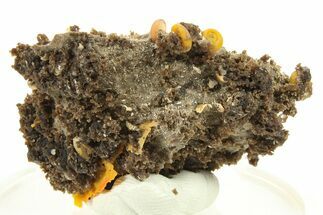This Specimen has been sold.
4.5" Pennsylvanian Fossil Brachiopod Plate - Kentucky
This is a slab of rock that contains several brachiopods that have been partially exposed, collected from the Breathitt Formation of Leslie County, Kentucky. It comes with an acrylic display stand.
The Breathitt Formation produces both marine and land fauna and flora fossils. About 300 million years, ago this region was a river delta next to the sea. During this period of deposition, shallow seas repeatedly came in and receded, resulted in marine layers between the coal, sandstone, and plant shale layers. These marine layers primarily contain brachiopods, but trilobite fossils have been reported in locations near this site.
Brachiopods are members of the phylum Brachiopoda. They are clam-like with wide shells composed of two halves called valves. They are filter feeders that live fixed to rocks or on the seafloor. Brachiopods first appeared in the early Cambrian as simple forms with non-articulating shells. Their diversity peaked during the Devonian, and there are currently 12,000 described fossil species of Brachiopoda from 5,000 genera. Most species of brachiopod died out during the Permian-Triassic Extinction but about 450 species still live today. They live in cold marine environments like polar seas or continental shelves and slopes. The largest fossil Brachiopod found is 7.9 inches (200 mm), but most are 2-4 inches (3-8 cm). Living Brachiopods also fall into this range.
Brachiopods are more closely related to Bryozoans than Mollusks. The easiest differences to identify are in the shells of clams, part of the mollusk family, and Brachiopods. Mollusk shells are divided into left and right while brachiopod shells are divided top (dorsal) and bottom (ventral). Mollusk shells are usually equal on the right and left. In brachiopods, the bottom shell is larger than the top. The other big difference is in how they feed: both are filter feeders, but mollusks extend their filter into the water and pull food into their shells. Brachiopods have internal feeding structures: water is drawn into the shell where the food is filtered out before expelling it out.
Brachiopods are more closely related to Bryozoans than Mollusks. The easiest differences to identify are in the shells of clams, part of the mollusk family, and Brachiopods. Mollusk shells are divided into left and right while brachiopod shells are divided top (dorsal) and bottom (ventral). Mollusk shells are usually equal on the right and left. In brachiopods, the bottom shell is larger than the top. The other big difference is in how they feed: both are filter feeders, but mollusks extend their filter into the water and pull food into their shells. Brachiopods have internal feeding structures: water is drawn into the shell where the food is filtered out before expelling it out.
SPECIES
Various Unidentified Brachiopods
LOCATION
Leslie County, Kentucky
FORMATION
Breathitt Formation
SIZE
4.5 x 2.8" Rock
CATEGORY
ITEM
#138900
We guarantee the authenticity of all of our specimens.
 Reviews
Reviews











